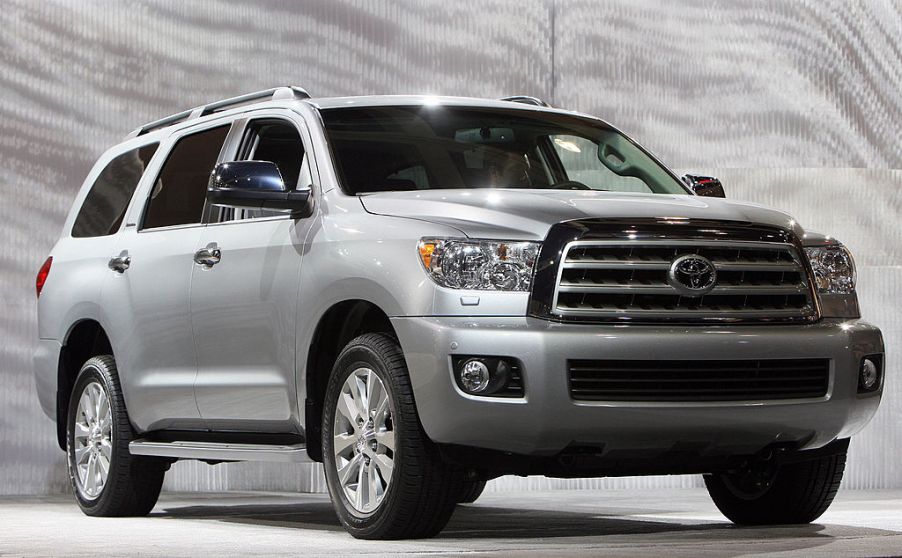
Now’s the Perfect Time to Buy a First-Generation Toyota Sequoia for Less Than $5K
Sequoias are tremendous trees native to California and are among some of the largest in the world. What a fitting name for Toyota’s largest SUV. When it was introduced in 2001, the Toyota Sequoia’s overall length of 204 inches and 118.1-inch wheelbase made it almost exactly the same size as the Ford Expedition and about five inches longer than the Chevy Tahoe and GMC Yukon. It was also nearly a full foot longer than Toyota’s iconic Land Cruiser.
Despite being exceptionally durable, highly capable of overlanding, and having a surprisingly luxurious interior, the Toyota Sequoia has always been largely underrated in the extremely narrow full-size SUV segment. For example, according to sales data from GoodCarBadCar, 152,305 Tahoes and 114,137 Expeditions were sold in 2005. By comparison, consumers bought just 45,904 Sequoia models.
Because Toyota Sequoias are widely overlooked, you can pick one up pre-owned at a great price. First-generation models, made from 2001-2007, are particularly affordable now.
The spectacular Toyota Sequoia
The design for the first-generation Toyota Sequoia was largely based on the wildly popular and award-winning Toyota Tundra, which was introduced in 2000. The two vehicles share a dashboard, chassis, and powerful 4.7-liter V8 engine with 240 hp. Combine that with the fact that early Sequoias also have the same practically indestructible drivetrain as the Land Cruiser, and you’ve got one heck of a vehicle – a big, commanding, and thoughtfully designed vehicle capable of towing up to 6,500 pounds.
Early Sequoia models were available in two trim levels: SR5 and Limited. Both trims could be configured with two-wheel or four-wheel drive. While the SR5 is plenty nice in its own right, the Sequoia Limited is downright luxurious. With the standard heated leather seats, dual-zone climate control, a roof rack, a rear spoiler, fog lights, and a premium JBL stereo system, you may forget you’re driving a Toyota. One unique and fairly rare feature even on the base model Sequoias is the roll-down rear liftgate window.
Toyota gave the Sequoia a refresh mid-generation in 2005. It got a fresh new grille and the engine power was boosted to 282 hp. The formerly open differential was replaced with a Torsen center differential in four-wheel-drive versions, and the entire four-wheel-drive powertrain got a slick new push-button switch. A navigation system was also optional as of 2005.
Toyota Sequoias aren’t fuel sippers
For years, high fuel prices made it cost-prohibitive to even consider buying a large SUV for many people. The Sequoia’s fuel economy is admittedly not its strong suit, getting 12 mpg in the city, 16 mpg on the highway, and 14 mpg overall. Even in the refreshed 2005-2007 models, gas mileage improved only slightly to 14 mpg in the city, 17 mpg on the highway, and 15 mpg overall.
Today’s more affordable fuel prices make the Toyota Sequoia a more viable option. In fact, Car and Driver listed first-generation models as some of the best used cars you can buy for $5,000. Edmunds.com lists more than 50 Sequoias for sale in that price range, and many of them are fully-loaded and in fantastic condition. High mileage shouldn’t be a concern as you’re highly likely to get well beyond 200,000 miles out of a Sequoia.
Issues to be aware of
In true Toyota fashion, the Sequoia is solid and dependable. However, we are talking about the first generation here, which means these vehicles are approaching 20 years old. As should be expected, they do have some minor issues.
There was a problem with improperly finished ball joints in several model years, resulting in a recall of 533,000 Sequoias and Tundras. The faulty ball joints could cause the front suspension to wear out prematurely. Toyota replaced them, so it’s unlikely you would find a used Sequoia that still had the original ball joints. Some pre-2004 Toyota Sequoia models also have frames that are more prone to rusting, a problem that was common in Tundras in the early 2000s as well.


